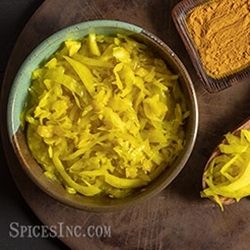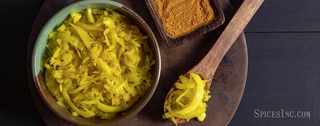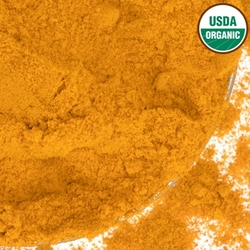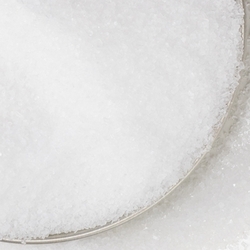Pineapple Turmeric Sauerkraut

Sauerkraut has long been associated with German cuisine, but this method of food preservation spread to Europe from China! During the period of time when the Great Wall was being built, people in China were living off of foods that primarily consisted of cabbage and rice. Fermenting foods is a great way to keep them good for longer, and it also encourages the growth of good bacteria that can potentially help your body with digestion.
When you are making your recipe, you can use a half gallon mason jar or split the recipe contents into two quart size jars, meaning you can easily gift one to your favorite neighbor and keep one for yourself. Be sure to loosen the tops of your jars so some of the gasses produced can escape, otherwise it will become pressurized and may explode when you go to open it next. We used apple cider vinegar in our recipe, but a white vinegar would be okay as well if that’s what you’ve got on hand.
The turmeric in this recipe lends to a very beautiful yellow coloring for the dish- making it vibrant and perfect for photographing if you like to make fancy dishes to post on your Instagram. Our taste testers loved the crunchiness of this recipe, and the flavor was rather interesting, in a good way. It was hard for some to wrap their heads around a pineapple sauerkraut, but if you think about it, you can make Pickled Blueberries and that sounds weird too. Don’t knock it until you try it! You will be pleasantly surprised by the tangy, sour, sort of sweet flavor much like those in our test kitchen were. This recipe is quite tasty and multidimensional. Eat it like a snack or as a side to many meat-based dishes. You can even drink the leftover brine after you’ve finished eating all the sauerkraut.
- For the Sauerkraut:
- 1 Head Green Cabbage, shredded
- ½ Half of a Pineapple, cut into ½ inch pieces
- 1 Tbsp Fresh Ginger, minced
- 1 Tbsp Sea Salt
- 1 Tbsp Organic Turmeric Powder
- For the Probiotic Brine:
- 1 Tbsp Sea Salt
- 1 Tbsp Raw Apple Cider Vinegar (with the mother, such as Bragg’s)
- 4 Cups Spring Water, reserve 1 cup for hot water
- Prepare your produce. Chop pineapple and shred the cabbage. Place into a large bowl. Add ginger and 1 Tbsp of Sea Salt as well. Prepare the brine by combining 1 Tbsp Sea Salt, Raw Apple Cider Vinegar, and Spring water together. (Add 1 cup of hot water first to dissolve salt)
- With your hands, mix the ingredients for a minute or two until it starts to become watery. Let rest for 20-30 minutes.
- Add Turmeric and mix well with tongs
- Using a Half Gallon Mason Jar or 2 Quart size Mason jars, pack the cabbage into the jars half way. Fill the rest of the jar with brine, leaving an inch at the top. Close lid tightly and give it a good shake to combine ingredients.
- Loosen lids slightly, so the fermentation gases can escape. Place in a cool, shaded area. During fermentation, some cloudiness might appear and it may bubble. Remove any “scum.” Shake the jar every day and make sure all the cabbage is under the brine, so it doesn’t mold.
- After the fermentation process is complete, store in refrigerator. Enjoy the extra brine as a healthful, probiotic drink!



